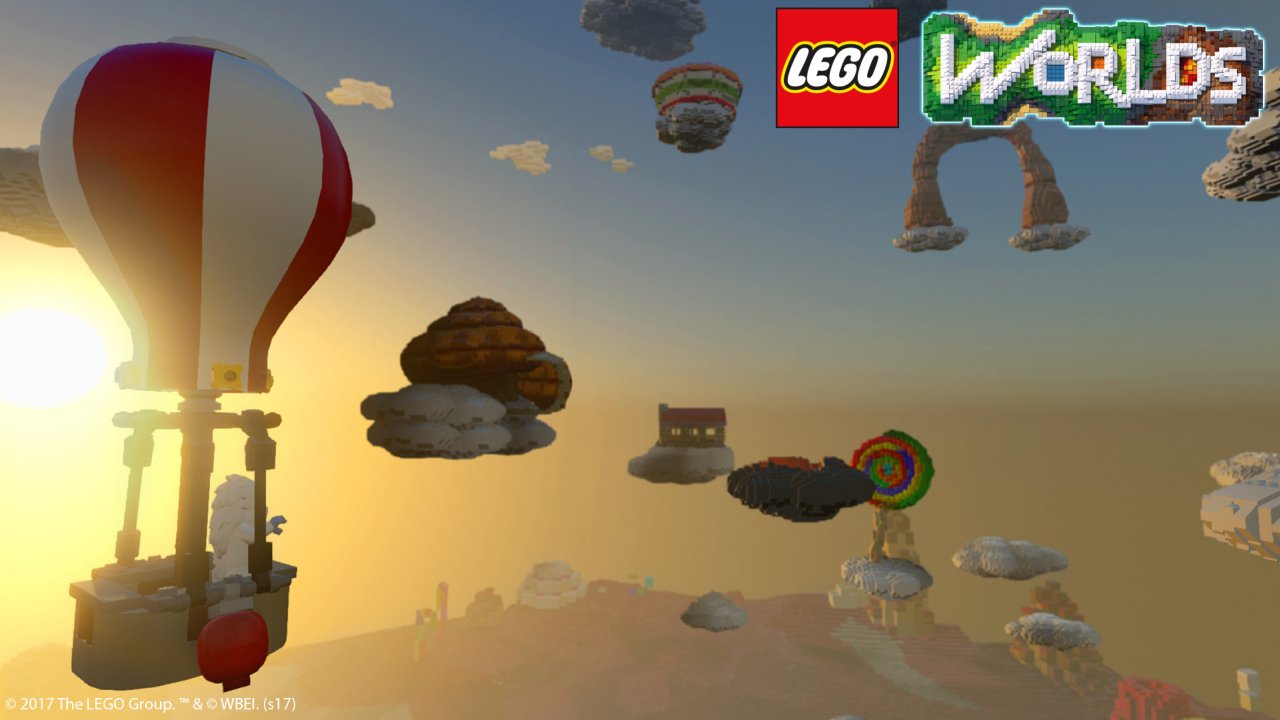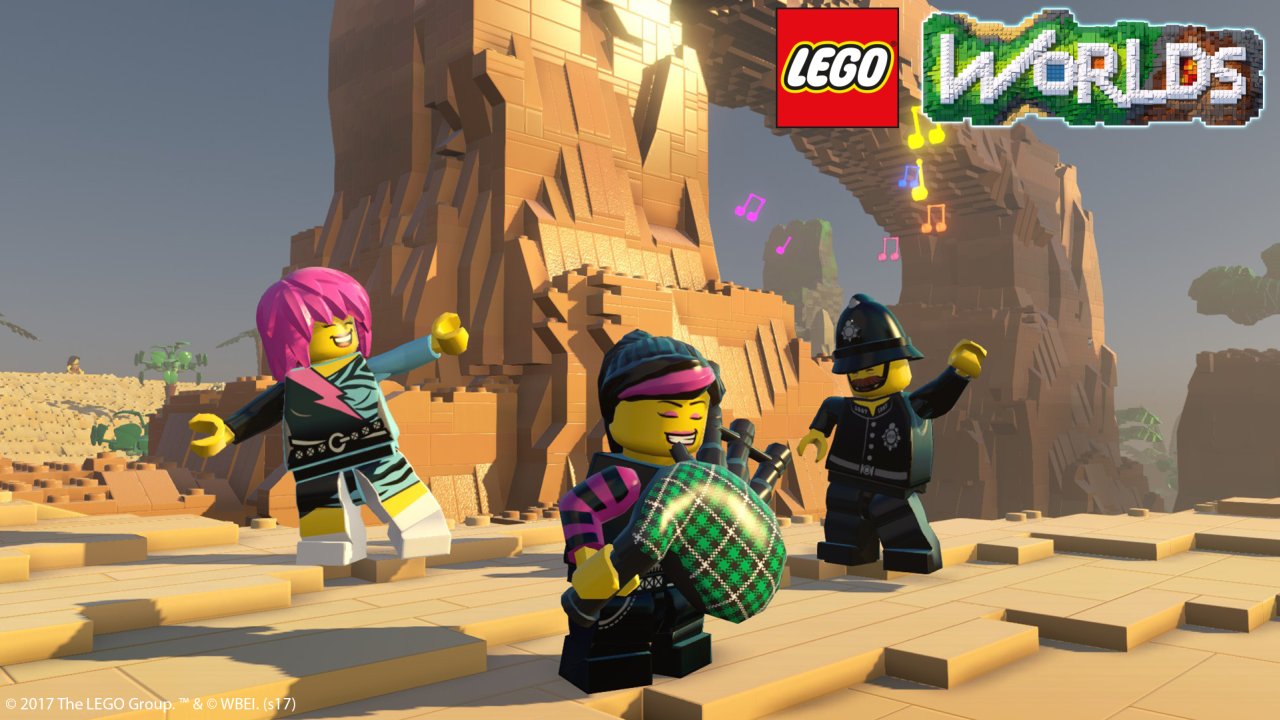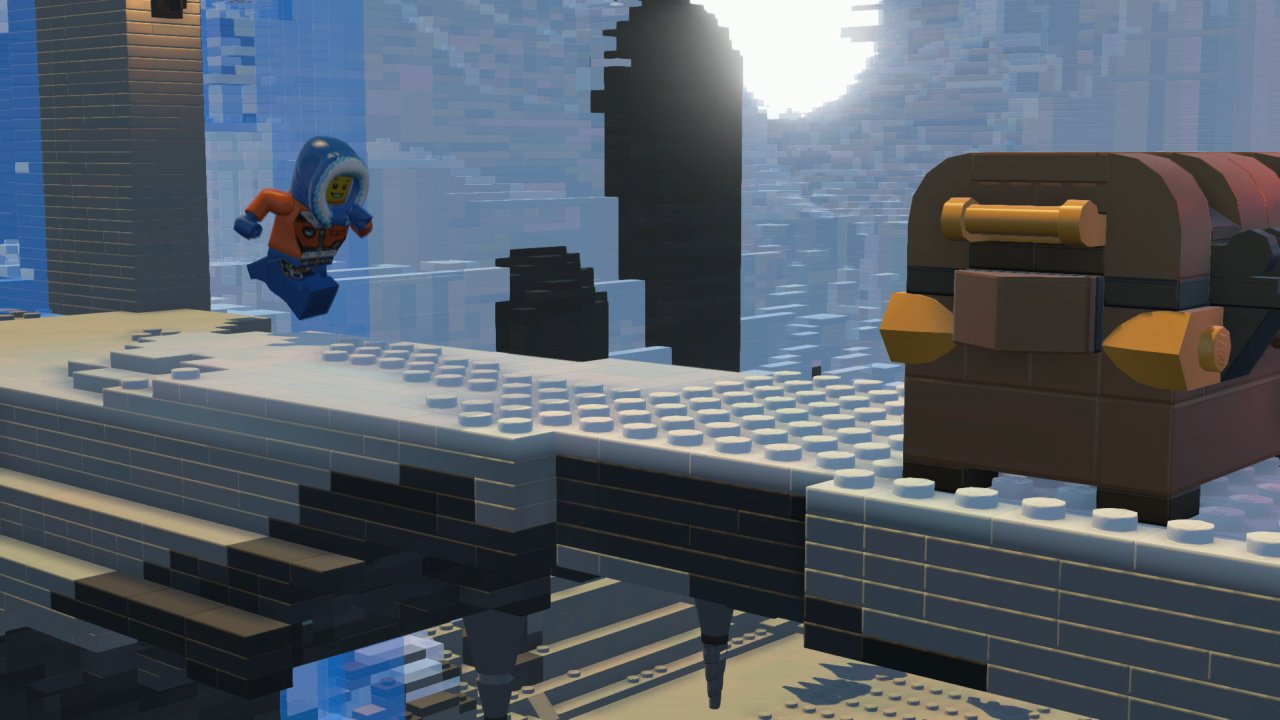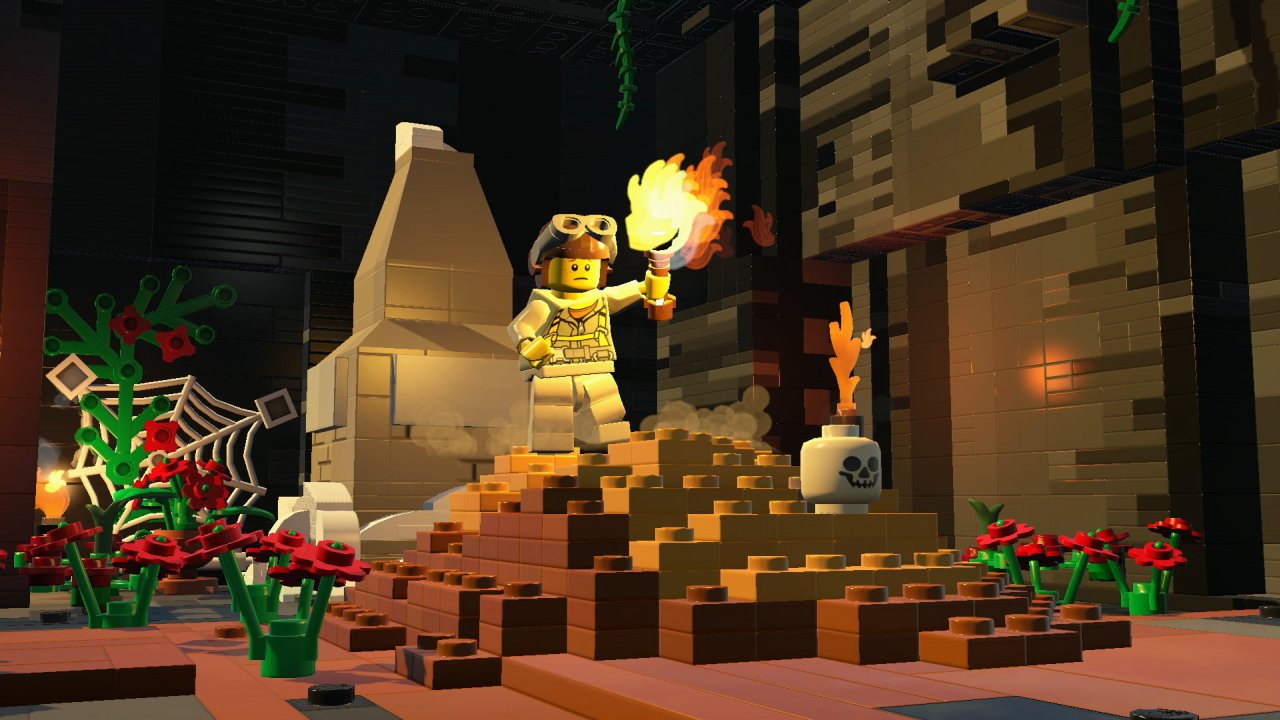LEGO Worlds Review
The brick building franchise expands to new, randomly generated worlds with mixed results
Warner Brothers and TT Games have been enjoying a string of rather successful LEGO adaptations in recent years. Combining the ever-popular brick building brand and its signature aesthetic with existing entertainment franchises – from Harry Potter to Star Wars and more – has proven to be a successful formula, and these games were able to deliver a steady stream of relatively fun experiences that consistently pleased fans. With more franchise adaptations and sequels likely on the way, the franchise has shown no signs of slowing down. More recently, they jumped on the physical toys-to-life subgenre with LEGO Dimensions. The latest title, however, is something entirely different. LEGO Worlds is not a singular adventure with a focus on action and story – instead, it is an exploration and creation game that hopes to tap into the very core of LEGO brick building fun.

If you’ve played some of the previous LEGO adventures, Worlds is different. There’s no story to speak of, no characters or dialogue. Players assume the role of a space explorer LEGO avatar with a single ship, who has set out on a quest to become a Master Builder. To achieve this status, you must collect Gold Bricks that are scattered across a potentially endless number of randomly generated worlds of increasing size and variety. An enthusiastic and occasionally humorous narrator provides you with a few basic instructions on how to handle the basics of the gameplay, and congratulates players as they rise through the ranks, but beyond that he doesn’t offer any sort of story. This is very much a game that’s purely meant for exploration, collecting, and building; this is not the sort of campaign experience you’d find in previous LEGO games.
Using their spaceship, the players can travel between any number of planets, which are all randomly generated. These aren’t full planets in the sense of No Man’s Sky or similar games – rather they are sections of a map, as you’d see in other building games like Minecraft or Disney Infinity. You get a preview of what the map looks like, and keep generating planets until you find one whose geography looks appealing. Over the course of the game, you’ll go on to discover a variety of different Biomes, from pirate islands to candy worlds, canyons and water worlds, forests and plains, prehistoric worlds and swamps, and more. While the game features a few different official LEGO brick and figure sets, there’s clearly potential here to expand with DLC in the future, especially when it comes to licensed content.
Upon landing on any such planet, players can explore to their heart’s content. You get the usual weapon wheel menu from where a number of tools can be selected. The first item you get access to is the Discover Tool – by pointing it at various items in the game world and pressing A, you discover/unlock them. It goes without saying that landing on each new planet is fairly exciting – items you haven’t unlocked yet glow, so you run around and scrounge up as much new stuff as possible. This basically fills out your available inventory, as you can spawn any item you’ve discovered at will. The annoying thing about the discovery process is that if you’ve already discovered something, pressing A on the item again “unlocks” it so the original can be interacted with/deleted from the world. This wastes studs, as you happily spam the A button in hopes of discovery and end up unlocking items by accident instead. Studs are, as fans will be familiar with, the currency in the game and acquired from quests, chests, and just breaking things apart.
The items you can scan fall into a few categories, such as characters, animals, vehicles, brick builds, and objects. You can customize the look of your avatar / space explorer with the items you’ve unlocked. There are drivable vehicles in the game of all sorts, from boats to motorbikes and submarines; some of them even have functionalities like digging through terrain. Characters and animals simply roam the world and don’t really have any meaningful interaction – though you can ride some of the animals and it looks amusing. The rest of the categories are self-explanatory; brick builds are complex structures that are built instantly such as houses, and objects are all non-brick items such as campfires, trees, barrels, flowers and so on.

While the Discover tool is used for item manipulation, the other major tools are for environment manipulation. The Build Tool offers an absolute ton of LEGO bricks to choose from (though most you’ll need to find/unlock first), and allows you to build anything you’d like piece by piece. Creating objects by snapping LEGO bricks together is quite straightforward, as your vision becomes focused on the brick rather than your character. You move the cursor around in the 3D space and can place bricks anywhere, including mid-air. From there, with a directional tap on the controller stick, the cursor automatically snaps to the end of the current brick so you can lay them all in a row quickly. Using the D-Pad you can adjust the precision to a high degree and get the angles and design just right. The bricks don’t have physical collision in the Build tool so placing them at odd angles or halfway up one another is OK.
Then there’s the Environment tool, which lets players adjust the game world itself. With physical alterations, players can raise mountains, create valleys, dig deep or build high. The tool is fairly robust and offers lots of editing cursors with different shapes and sizes, as well as functions, to get the terrain adjusted to your liking. You can also add and remove entire chunks of the environment, or replace it with water, snow, lava or any of the other materials included. Everything in this tool is unlocked from the start. If you ever dig too deep or build too high, not to worry – you can respawn and parachute back into the map from above, or you can also jump/climb out even on vertical surfaces. The final editing device is the Paint tool, which lets you throw paint at brick walls; there are plenty of colors and again all are unlocked from the get-go. There’s also a Copy tool, which lets you select a 3D space and create a copy of it. This copy is placed into your Discovery tool’s list of brick builds, and you can spawn the entire structure at will.
Unfortunately most of the tools can be rather cumbersome to use. Operating the floating terrain editing tools often throws the camera into strange positions, and if you’re editing underground, it’s impossible to see what you’re doing unless you look directly from above. Getting the camera to float behind objects or the game world obscures your view entirely. Switching between the tools and their various functions takes a while, and the controls layout isn’t overly intuitive. There is an advanced build mode where the Tools wheel menu instead becomes a ribbon at the top of the screen, but it only saves a bit of time. In all the tools, beyond the categories, there is no way to search or sort through the tens of items, bricks, and colors that you have access to. General player controls feel a bit awkward too, with climbing/punching/running feeling clunky. Swimming and exploring underwater is even more so, immersive as it may be. On the galaxy screen, a mouse-like manual cursor is used for some menus which seems odd and out of place.
You can fully explore and interact will all of the worlds you generate, and save your progress. Unleashing your creative prowess can be satisfying, especially if you enjoy similar games. However if you want to create a specific world to build in – say a candy world with a couple of different Biomes – you will first need to become Master Builder, having collected all 100 Gold Bricks. This aligns with the game’s focus on exploration and discovery, however it grows extremely repetitive, especially if you just want to build. As mentioned earlier, these bricks can be earned in a variety of ways, but there are only a few on each world you generate. At first, you will need to travel between very small worlds until you’ve collected 25 and can create medium sized worlds, and then eventually get to larger and huge worlds once a certain number is amassed.

On each world, your map helpfully displays your general location as well as any points of interest – such as quest NPCs, treasure chests, and animals – however it can be difficult to see some icons clearly. Beams of light shoot out into the sky from the locations where something important is located – such as a hidden chest or a Troublemaker. Quests make up a large source of Gold Bricks. You will meet NPCs on the planets who often need something from you – usually a fetch task. The quests range from needing a specific item, to clearing obstacles, building a specific structure, taking a rare photo, and so on. Once you got the Gold Brick, the same quests can be repeated and farmed for studs. Getting the 100 Gold Bricks is a time consuming and repetitive task, and you’ll need to see a ton of randomly generated planets and complete a ton of quests. Some quest chains span multiple worlds, but their length feels cumbersome.
You could also get Gold Bricks from Troublemakers – these green creatures spawn randomly, and need to be chased down to take what they are carrying. In larger worlds, there could be towns or even dungeons. In dungeons, you’ll be facing off against a maze-like environment with lots of traps and enemies. At the end, your reward is plenty of studs as well as a couple of chests. You can always cheat, too – use the Environment tool to trap Troublemakers, or dig directly down to the dungeon chest. Chests/Troublemakers will have plenty of other rewards, such as rare bricks for the Build tool or items for your inventory, customization options, and unlock ability to Discover that character/creature.
As we’ve just mentioned enemies – yes, the game does have some skeletons and other creatures that come out during the night and are aggressive to the player. Dealing with them requires weapons in your inventory for maximum effectiveness, but in general dying just loses you some studs and you respawn right in the same area. You may also lose items from your inventory, but they can be recovered. There is also a trader that appears at night, and sells rare and expensive items in exchange for studs.
The game doesn’t really impress with its visuals or audio – the classic LEGO look is preserved, but the effects and textures are not very high quality. The narrator does OK, but he’s infrequent and the background music is just basic tunes that accompany your exploration and building efforts. In turn, LEGO Worlds struggles from the technical perspective. There are plenty of framerate issues on the Xbox One, especially if you push the environment to its virtual limits or explore underwater or in caves. Even going to a different planet doesn’t improve performance until you restart the entire game, and it can chug almost as low as a slideshow. There are plenty of physical glitches and other bugs, and worryingly the game reported a corrupt save file on a couple of occasions that we needed to restore from a backup. The lower retail price point of the game helps soothe the annoyances only a tiny bit.

You can share your creative prowess with others via local or online cooperative play. As with most games aimed at younger audience, the online function is limited to directly inviting others on your friends list rather than matchmaking. There's also an option whether or not to save the changes that you make in multiplayer, so that others cannot mess up the things you've been working on. When playing in local co-op mode, it can be fun to build and explore together, but progress isn't saved for the second player. Numerous bugs and glitches also appear when playing with another, such as duplication of items and quests, and plenty of other bugs and scripting problems that seem exclusive to multiplayer sessions. Performance also gets even worse when the console has to render the actions of both players. It's all rather disappointing to see.
LEGO Worlds is a decent attempt to simulate the brick building experience in the digital realm. Its foundation is sound – with plenty of powerful tools to create, destroy, and adjust the game world – but the execution is not the best, with some awkward controls and occasional bugs. Further, to even get to the free build mode, you’ll need to spend hours discovering the many items across random worlds, on the hunt for Gold Bricks. It’s fantastic to have a purpose in a typically free-form building game such as this, but the journey ends up being an overlong and repetitive series of fetch quests and digging for chests. Though the game looks alright, technical issues will surely frustrate many aspiring builders. While LEGO Worlds could certainly be the cheapest way to gain access to nearly endless supply of LEGOs, the gameplay doesn’t exactly simulate the satisfaction or precision of building something with your hands.
 Comments
Comments


















